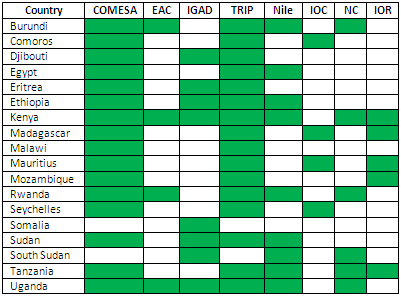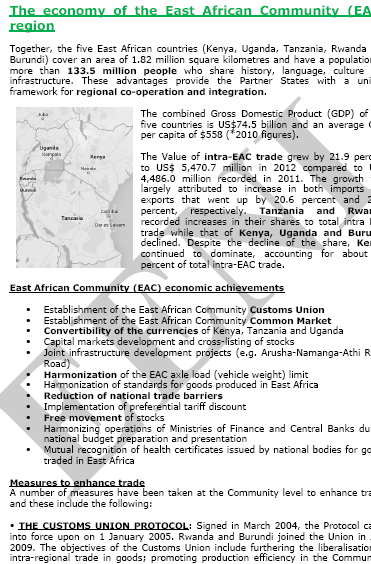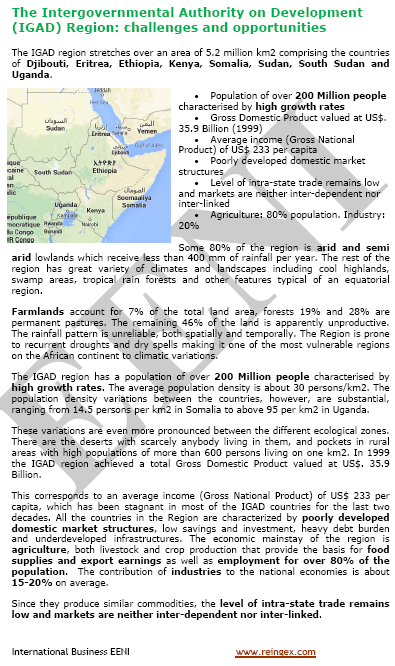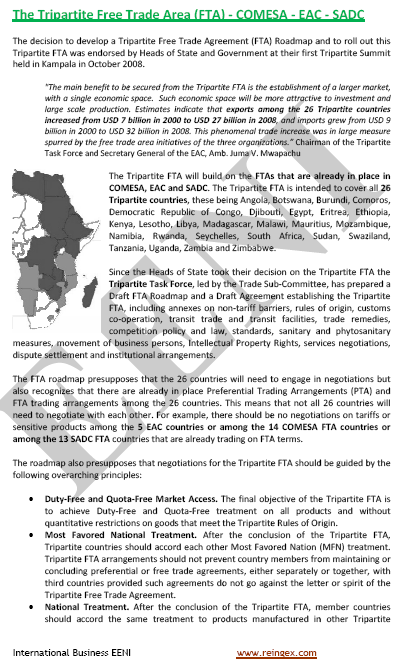Adaptation Eastern Africa Students (Bachelor, Trade)
Adaptation of the Bachelor of Science to Eastern Africa Students (Bachelor of Science in International Trade, e-learning)
| Bachelor of Science in International Trade |

Subject - “Adaptation of the Bachelor of Science to Eastern Africa Students (Study of the main regional economic institutions of the region where the student lives)” (5 ECTS) - Online Bachelor of Science in International Trade (fourth semester).
Subjects for Eastern Africa Students
Proposed subjects for Eastern Africa Students: Burundi, the Comoros, Djibouti, Egypt, Eritrea, Ethiopia, Kenya, Madagascar, Malawi, Mauritius, Mozambique, Uganda, Rwanda, the Seychelles, Somalia, Sudan, South Sudan, and Tanzania.

- Common Market for Eastern and Southern Africa (COMESA)
- East African Community (EAC)
- Intergovernmental Authority on Development (IGAD)
- Southern African Development Community (SADC)
- COMESA-EAC-SADC Tripartite FTA
- International Conference on the Great Lakes Region (CIRGL)
- CEN-SAD
- IORA
- Nile Basin Initiative (NBI)
- Indian Ocean Commission (COI)
- Economic Community of the Great Lakes Region (CEPGL)
- Africa-European Union Strategic Partnership (EU)
- GSP
- AGOA
Syllabus of the Program: Common Market for Eastern and Southern Africa (COMESA).
- Introduction to the Common Market for Eastern and Southern Africa (COMESA)
- Decision Making of the COMESA
- COMESA Integration Process;
- COMESA Free-trade area
- COMESA Customs Union
- COMESA Common Market
- COMESA Economic Community
- Trade facilitation in the Common Market for Eastern and Southern Africa
- Simplified cross-border procedures for small companies
- Non-tariff and Technical Barriers to Trade elimination
- Economy of the COMESA region.
- International Trade of the COMESA
- Intra-COMESA Trade
- Trade in services
- Investments in the COMESA region
- Industry
- Energy
- Agriculture of the region of the Common Market for Eastern and Southern Africa
- Comprehensive Africa Agriculture Development Programme
- Alliance for Commodity Trade in Eastern and Southern Africa
- Harmonization Program of Sanitary and Phytosanitary Measures
- Infrastructures in the COMESA region.
- Transport facilitation
- Information and communication technologies
- Institutions and Agencies of the Common Market for Eastern and Southern Africa
- COMESA Reinsurance Company
- COMESA Regional Investment Agency
- African Trade Insurance Agency
- Federation of National Associations of Women in Business of the COMESA
- COMESA Entrepreneurs Council
Objectives of the Program “Common Market for Eastern and Southern Africa”:
- To understand the objectives, functions and institutions of the Common Market for Eastern and Southern Africa
- To know the economy of the COMESA region
- To analyze the COMESA Integration Process: the free-trade area, the Customs Union, the Common Market and the Economic Community COMESA
- To evaluate the advantages for the member countries of the COMESA
- To know the COMESA trade and transport facilitation programs
- To analyze the role of the affiliated institutions: the Bank of the ZEP, AIRC, the COMESA Reinsurance Company, ACA
United States-COMESA Trade and Investment Framework Agreement.
- The U.S.-COMESA countries (Common Market for Eastern and Southern Africa) Trade and Investment Framework Agreement (TIF)
- International Trade between the U.S. and the countries of the COMESA
- Advantages of the U.S.-COMESA Trade and Investment Framework Agreement
Syllabus of the Program: East African Community (EAC).
- Introduction to the East African Community (EAC)
- Trade Regime of the East African Community
- The main provisions of the EAC Agreement
- Agencies of the Community
- Structure and functions of the Secretary of the East African Community
- Creation of the EAC Customs Union
- Creation of the EAC Common Market
- Monetary and financial cooperation
- Treaty for the establishment of the East African Community
- East African Development Bank
Objectives of the Program “East African Community (EAC)”:
- To understand the objectives and functions of the East African Community
- To evaluate the advantages for the member countries and the areas of cooperation between the East African Community
- To analyze the Economic Integration process (Customs Union and Common Market) and International Trade between the member countries of the East African Community
- To know the role of the East African Development Bank
East African Community (EAC)-United States Trade and Investment Partnership Agreement.
- Introduction to the Trade and Investment Partnership Agreements between the East African Community (EAC) and the U.S.
- Objectives of the Association Agreement
- International Trade between the countries of the EAC and the U.S.
Syllabus of the Program: Intergovernmental Authority on Development (IGAD).
- Introduction to the Intergovernmental Authority on Development (IGAD)
- Region of the IGAD
- IGAD Regional Integration Process
- Challenges and opportunities of the region of the IGAD
- Partners Forum of the Intergovernmental Authority on Development
- Economic Cooperation and social development
- Economy, International Trade, industry, tourism, Transport and information and communication technologies in the region of the IGAD
Objectives of the Program “Intergovernmental Authority on Development (IGAD)”:
- To understand the objectives and institutions of the Intergovernmental Authority on Development
- To evaluate the advantages for the member countries of the IGAD and the areas of cooperation (economic, social...)
- To analyze the regional economic integration process and International Trade between the member countries of the Intergovernmental Authority on Development
Syllabus of the Program: Southern African Development Community (SADC).
- Introduction to the Southern African Development Community (SADC)
- The main institutions of the Southern African Development Community
- History of the SADC
- Treaty of the SADC
- Economic profile of the region of the SADC
- SADC Strategic Plans
- Economic development in Southern Africa
- International Trade in the region of the Southern African Development Community
a- Trade liberalization
b- Customs and trade facilitation
c- Competition Policy
d- Non-tariff barriers
e- Trade in services
f- Trade Development Program of the SADC - Regional Indicative Strategic Development Plan
- Directorate of Trade, Industry, Finance and Investments
- Integration Process in the Southern African Development Community
a- SADC Free-trade area
b- SADC Customs Union
c- SADC Common Market
d- SADC Economic and Monetary Union
e- Single Currency - Support Program for the SADC Regional Economic Integration
- Infrastructures and services in the region of the Southern African Development Community
- Transport in the SADC region
- Maritime transport, ports and waterways - ICT and telecommunications
- Tourism
- Food, agriculture and natural resources
- Southern Africa Trade Hub
- Protocol against corruption of the SADC
- Trade Agreements of the SADC
Objectives of the Program “Southern African Development Community (SADC)”:
- To understand the objectives and the affiliated institutions of the Southern African Development Community
- To evaluate the advantages for the member countries of the SADC and the areas of cooperation
- To analyze the Economic Integration process: the free-trade area of the SADC, Customs Union, Common Market, Economic and Monetary Union and the single currency
- To analyze the intra-SADC Trade
- To know the Regional Indicative Strategic Development Plan of the Southern African Development Community
- To explore free trade agreements of the Southern African Development Community
Syllabus of the Program: COMESA-EAC-SADC Tripartite Free Trade Agreement.
- Introduction to the COMESA-EAC-SADC Tripartite FTA
- Institutional framework
- Areas of intervention
- Tripartite free-trade area
- Trade facilitation and Transport
- Infrastructure Development
- Mechanisms related to trade
- Corridors and infrastructures of the COMESA region-SADC-EAC
- towards the African Continental Free-Trade Area
Objectives of the Program “COMESA-EAC-SADC Tripartite Free Trade Agreement”:
- To understand the objectives (Customs Union) and the areas of cooperation of the COMESA-EAC-SADC Tripartite FTA
- To evaluate the advantages for the member countries of the tripartite
- To understand the advantages of the Tripartite free-trade area
- To analyze trade facilitation programs, transportation, and non-tariff barriers elimination
- To understand the Tripartite Agreement as a stage towards the African Continental Free-Trade Area
Syllabus of the Program: International Conference on the Great Lakes Region.
- Introduction to the International Conference on the Great Lakes Region
- The main programs of the Conference
- Peace, security, democracy and good government
- Economic development and regional integration
- Northern Corridor
- Trans-African highway (Mombasa-Lagos)
- Lobito Corridor
- South Corridor
- Humanitarian and social issues
- Cross-cutting issues
Objectives of the Program “International Conference on the Great Lakes Region”:
- To understand the objectives and functions of the International Conference on the Great Lakes Region
- To evaluate the advantages for the member countries of the International Conference on the Great Lakes Region and the areas of cooperation
- To analyze the economic development and regional integration
Syllabus of the Program: Organization for the Harmonization of Business Law in Africa (OHADA).
- Introduction to the Organization for the Harmonization of Business Law in Africa (OHADA)
- OHADA Uniform Acts
- Commercial law in Africa
- Commercial Companies Law
- Law on Guarantees and Bonds
- Cancellation of liabilities in case of insolvency
- Arbitration Law of the Organization for the Harmonization of Business Law in Africa
- Organization and harmonization of corporate accounting
- Contracts of carriage of goods by road
- Cooperatives Law
- Treaty on the Harmonization of the African Business Law
Objectives of the Program “Organization for the Harmonization of Business Law in Africa (OHADA)”:
- To understand the objectives (legal integration) of the Organization for the Harmonization of Business Law in Africa
- To know the OHADA Uniform Acts
- To analyze the implications for business and companies
- To understand the role of the OHADA in African Integration
Syllabus of the Program: Community of Sahel-Saharan States (CEN-SAD).
- Introduction to the Community of Sahel-Saharan States (CEN-SAD)
- Member states of the CEN-SAD
- Sahel-Saharan Bank for Investment and Trade (BSIC)
- African Initiative of the Great Green Wall
- Regional Food Security Programme
Objectives of the Program “Community of Sahel-Saharan States (CEN-SAD)”:
- To understand the objectives of the CEN-SAD
- To evaluate the advantages for the member countries of the Community of Sahel-Saharan States
- To analyze the areas of cooperation and programs of the CEN-SAD
- To know the role of the Sahel-Saharan Bank for Investment and Trade
Syllabus of the Program: Indian-Ocean Rim Association (IORA).
- Introduction to the Indian-Ocean Rim Association (IORA)
- Countries of the IORA
- Objectives, structure and specialized agencies of the IORA
- IORA Business Forum
- Action Plan of the Indian-Ocean Rim Association
- Working areas and priorities;
- Trade and Investment Facilitation. The Preferential Trade Agreement (PTA)
- Fisheries management
- Maritime safety and security
- Disaster risk management
- Tourism
- Gender empowerment
- Projects of the Indian-Ocean Rim Association (IORA)
- Chart of the Indian-Ocean Rim Association (IORA)
Objectives of the Program “Indian-Ocean Rim Association (IORA)”:
- To understand the objectives, structure and institutions of the IORA
- To know the functions of the IORA working group on Trade and Investment
- To evaluate the advantages for the member countries of the IORA and the areas of cooperation
Syllabus of the Program: Indian Ocean Commission (COI)
- Introduction to the Indian Ocean Commission
- Secretariat of the Commission
- Countries of the Indian Ocean Commission: the Union of the Comoros, the Reunion Island, Madagascar, Mauritius and the Seychelles
- Regional Economic Infrastructure
- European Union and the Indian Ocean Commission
- Rules and certificate of origin of the Indian Ocean Commission
Syllabus of the Program: Economic Community of the Great Lakes Region (CEPGL).
- Introduction to the Economic Community of the Great Lakes Region (CEPGL)
- Agencies of the Economic Community
- International Society of Energy of the countries of the Great Lakes: Burundi, the DR Congo, and Rwanda
- Regional Economic Program 2014-2020
- Economic Integration, Investments, International Trade, and Promotion
- Private Sector Forum of the Economic Community
- Northern Corridor
Syllabus of the Program: Nile Basin Initiative (NBI)
- Introduction to the Nile Basin Initiative (NBI)
- Economic profile of the Nile Basin
- Advantages for Burundi, the DR Congo, Egypt, Ethiopia, Kenya, Rwanda, South Sudan, Sudan, Tanzania, and Uganda
- Structure of the Nile Basin Initiative
- Plans and strategic projects of the Nile Basin Initiative
Syllabus of the Program: Africa-European Union Strategic Partnership (EU)
- Introduction to the Africa-European Union Strategic Partnership (EU). The Cotonou Agreement
- Fiduciary Fund European Union-Africa for the infrastructures
- Cotonou Agreement
- ACP countries
- Barcelona Declaration and the Euro-Mediterranean Partnership
- European Neighborhood Policy
- Bilateral relations Africa-EU
Syllabus of the Program: Generalized System of Preferences (GSP) of the EU.
- Introduction to Generalized System of Preferences (GSP) of the EU
- New GSP System (2014-2024)
- Revised EU trade scheme to help the developing countries
- Beneficiary countries under the current Generalized System of Preferences
- Products enjoying preferences in the reformed GSP
- Practical guide to the new GSP trade regimes for the Developing Countries
- The three EU import regimes
- European Union's Foreign Trade with GSP countries
- GSP+ scheme
- Everything But Arms arrangement (EBA)
- Duty-free and Quota-free treatment for all least-developed countries
- GSP rules of origin
- Tolerance or De Minimis
- Types of accumulation
Objectives of the Program “Generalized System of Preferences (GSP)”:
- To know the characteristics of the new Generalized System of Preferences of the EU
- To analyze the SPG + scheme and the arrangement Everything but Arms
- To know which countries and under what conditions are beneficiaries of the GSP
- To know how to use the rules of origin under the Generalized System of Preferences
Syllabus of the Program: African Growth and Opportunity Act (AGOA).
- Introduction to the AGOA
- Modifications of the AGOA
- Eligibility criteria: countries and products. The case of the African textiles
- International Trade between the U.S. and Africa
- The main export markets
- The main suppliers of Sub-Saharan Africa to the U.S.
- North American Investment in Africa
- African Foreign Trade Centre
- Case Study:
- Handcrafts export growth in Ghana
- Senegalese Exporters
- African Growers at Floral Show in Atlanta
Objectives of the Program “African Growth and Opportunity Act (AGOA)”:
- To understand the objectives of the African Growth and Opportunity Act
- To evaluate the admission criteria by country and product eligibility
- To understand the general rules of origin for textiles under the AGOA
- To analyze the access to the U.S. Market for the African products under the AGOA
- To know the trade agreements between the African Countries and the U.S.
- To analyze the international trade between the African Countries and the U.S.
Samples: adaptation of the Bachelor of Science to Eastern Africa Students (Study of the main regional economic institutions of the region where the student lives) (Bachelor of Science in International Trade, e-learning, fourth semester).





Language of the subject “adaptation of the Bachelor of Science for Eastern Africa Students (Study of the main regional economic institutions of the region where the student lives)” of the Bachelor of Science in International Trade (fourth semester):  Bachelor of Science en Comercio Internacional
Bachelor of Science en Comercio Internacional  Bachelor of Science en commerce international
Bachelor of Science en commerce international 
 Bachelor of Science em Comércio Internacionale.
Bachelor of Science em Comércio Internacionale.
(c) EENI Global Business School (1995-2024)
We do not use cookies
Top of this page

